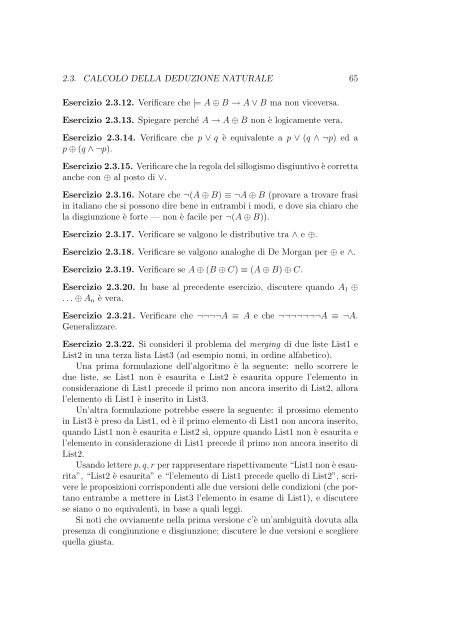Logica Matematica Corso di Laurea in Informatica ... - Mbox.dmi.unict.it
Logica Matematica Corso di Laurea in Informatica ... - Mbox.dmi.unict.it
Logica Matematica Corso di Laurea in Informatica ... - Mbox.dmi.unict.it
You also want an ePaper? Increase the reach of your titles
YUMPU automatically turns print PDFs into web optimized ePapers that Google loves.
2.3. CALCOLO DELLA DEDUZIONE NATURALE 65<br />
Esercizio 2.3.12. Verificare che |= A ⊕ B → A ∨ B ma non viceversa.<br />
Esercizio 2.3.13. Spiegare perché A → A ⊕ B non è logicamente vera.<br />
Esercizio 2.3.14. Verificare che p ∨ q è equivalente a p ∨ (q ∧ ¬p) ed a<br />
p ⊕ (q ∧ ¬p).<br />
Esercizio 2.3.15. Verificare che la regola del sillogismo <strong>di</strong>sgiuntivo è corretta<br />
anche con ⊕ al posto <strong>di</strong> ∨.<br />
Esercizio 2.3.16. Notare che ¬(A ⊕ B) ≡ ¬A ⊕ B (provare a trovare frasi<br />
<strong>in</strong> <strong>it</strong>aliano che si possono <strong>di</strong>re bene <strong>in</strong> entrambi i mo<strong>di</strong>, e dove sia chiaro che<br />
la <strong>di</strong>sgiunzione è forte — non è facile per ¬(A ⊕ B)).<br />
Esercizio 2.3.17. Verificare se valgono le <strong>di</strong>stributive tra ∧ e ⊕.<br />
Esercizio 2.3.18. Verificare se valgono analoghe <strong>di</strong> De Morgan per ⊕ e ∧.<br />
Esercizio 2.3.19. Verificare se A ⊕ (B ⊕ C) ≡ (A ⊕ B) ⊕ C.<br />
Esercizio 2.3.20. In base al precedente esercizio, <strong>di</strong>scutere quando A1 ⊕<br />
. . . ⊕ An è vera.<br />
Esercizio 2.3.21. Verificare che ¬¬¬¬A ≡ A e che ¬¬¬¬¬¬¬A ≡ ¬A.<br />
Generalizzare.<br />
Esercizio 2.3.22. Si consideri il problema del merg<strong>in</strong>g <strong>di</strong> due liste List1 e<br />
List2 <strong>in</strong> una terza lista List3 (ad esempio nomi, <strong>in</strong> or<strong>di</strong>ne alfabetico).<br />
Una prima formulazione dell’algor<strong>it</strong>mo è la seguente: nello scorrere le<br />
due liste, se List1 non è esaur<strong>it</strong>a e List2 è esaur<strong>it</strong>a oppure l’elemento <strong>in</strong><br />
considerazione <strong>di</strong> List1 precede il primo non ancora <strong>in</strong>ser<strong>it</strong>o <strong>di</strong> List2, allora<br />
l’elemento <strong>di</strong> List1 è <strong>in</strong>ser<strong>it</strong>o <strong>in</strong> List3.<br />
Un’altra formulazione potrebbe essere la seguente: il prossimo elemento<br />
<strong>in</strong> List3 è preso da List1, ed è il primo elemento <strong>di</strong> List1 non ancora <strong>in</strong>ser<strong>it</strong>o,<br />
quando List1 non è esaur<strong>it</strong>a e List2 sì, oppure quando List1 non è esaur<strong>it</strong>a e<br />
l’elemento <strong>in</strong> considerazione <strong>di</strong> List1 precede il primo non ancora <strong>in</strong>ser<strong>it</strong>o <strong>di</strong><br />
List2.<br />
Usando lettere p, q, r per rappresentare rispettivamente “List1 non è esaur<strong>it</strong>a”,<br />
“List2 è esaur<strong>it</strong>a” e “l’elemento <strong>di</strong> List1 precede quello <strong>di</strong> List2”, scrivere<br />
le proposizioni corrispondenti alle due versioni delle con<strong>di</strong>zioni (che portano<br />
entrambe a mettere <strong>in</strong> List3 l’elemento <strong>in</strong> esame <strong>di</strong> List1), e <strong>di</strong>scutere<br />
se siano o no equivalenti, <strong>in</strong> base a quali leggi.<br />
Si noti che ovviamente nella prima versione c’è un’ambigu<strong>it</strong>à dovuta alla<br />
presenza <strong>di</strong> congiunzione e <strong>di</strong>sgiunzione; <strong>di</strong>scutere le due versioni e scegliere<br />
quella giusta.




![Introduzione ai sistemi Wiki [PDF] - Mbox.dmi.unict.it](https://img.yumpu.com/16413205/1/184x260/introduzione-ai-sistemi-wiki-pdf-mboxdmiunictit.jpg?quality=85)











